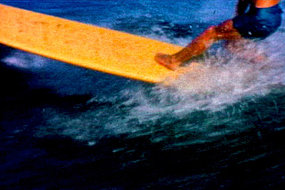Australian Broadcasting Corporation Reviews The Living Curl

California goes surfing, surfing super 8

Still from the feature documentary Living Curl. (The Living Curl)
By Mark Bannerman
Posted Fri Jan 29, 2010 4:25pm AEDT
Updated Fri Jan 29, 2010 4:26pm AEDT
No doubt about it nostalgia is big business. But every once in a while you come across something, a piece of music, a film or a book that perfectly and frighteningly recalls a long forgotten past that shocks you.
That’s exactly the feeling you have when you watch director Jamie Budge’s film, The Living Curl. Yes it is a surfing movie. Yes it does have a cast of names that might draw blank stares from anyone under 50 but it is a remarkable document that manages to capture an unspoilt place and the innocence of a sport that would soon explode into the public consciousness.
When this movie was made it was possible, in California, to go surfing in the morning, catch crayfish in the afternoon and cook them over an open fire in the evening before going to sleep on the beach.
How things have changed.
It was 1960 and Jamie Budge was just a kid when he started shooting 8mm film of his favourite surfers. He travelled the Californian coast documenting the people, the places and the waves he saw.
Keen to share what he’d seen he’d rent small halls and advertise his films charging 25 cents a person. As he tells it, after surfers paid their admission and saw the 8mm projector, many would often head to the door and demand their money back. Budge would plead with them to stay. Then after reluctantly returning to their seats and watching The Living Curl, they would compliment Budge on his masterpiece of Californian surfing.
They had every reason to be delighted. Not only did they get to see all the great surfers of the day, including Miki Dora, Johnny Fain and Lance Carson doing moves they could only dream of, but they were given something else too … that’s even clearer today. Looking through the eyes of a 16-year-old we see California as it was. Brown hills, blue water, massive kelp beds and the glimmer of the sun.
What the film also does is lay bare what we might call he “Faustian bargain” struck by those pioneer surfers or any adventurer who dares to make a living marketing their cherished lifestyle. In other words you want to surf, you sell the sport and hey presto the crowds begin to destroy the very essence of what you’ve found.
If you’ve read anything at all about Miki Dora, sometimes called the king of Malibu Beach, then you’d know that Dora and and many of his contemporaries never quite made the adjustment from the days when when they had the ocean to themselves and the time after the movie Gidget and the Beach Boys when every young boy and girl wanted to be on the sand either sunning, swimming or riding a surfboard.
There is a marvelous scene in the movie that takes us to a Hollywood movie shoot where they are making a version of Beach Blanket Bingo. Here we see all the movie muscle men and the phoniness that goes with those situations but out in the water guess who’s taking money to be the surfing stuntmen? Miki Dora of course and his other pals who hate the general public’s new-found interest in their pastime.
When the movie isn’t taking us to film shoots and assorted parties we travel in a gas guzzling car up and down the California coast highway. We are proudly told you can fill up for 25 cents a gallon! There’s another shock coming though and this is the true wonder of the movie. What you are hit by is, what’s not there. As we travel from one empty location after another we see the landscape as it was, unadorned by houses, development of almost any sort. In short the California Dream that so many wrote about and many more somehow try to hang onto.
In one remarkable scene two young surfers leave their car, climb a massive sandhill and then use what look like the decks of skateboards to “snowboard” down the hill. Had they had their wits about hem they would have run straight to the patent office and won the rights to the modern concept of a snowboard but these were more innocent times. With sand beginning to chaffe they head for the Pacific Ocean across the road to rinse off before continuing their trip.
Perhaps the most poignant moment in the movie comes when we go to the first surf contest ever held at Malibu Beach. There the contradictions of surfing are laid bare. Here a group of people, often better known for their colourful characters than their surfing, who’ve very deliberately put themselves outside the “normal” social confines are dragged kicking and screaming into the future.
Why has this movie suddenly been had its second coming now? Well the digital age has made this possible and the net assists in creating awareness (the major movie companies would certainly never gamble their money on this) but there is something else going on too, you suspect. Surfing writer Nick Carroll, who’s spent a good deal of time in California editing and writing about surfing reflected recently that Americans have an obsession with the California of a by-gone era. The golden state is the dream that many hold onto rather than the one that confronts them each day on the free-ways, the strip malls and the crowded stretches of ocean that is their homeland.
Right now there’s definitely a hunger for the old days. Perhaps surfing like popular music is stagnating. Other films have been re-mastered and re-released recently including big wave rider Greg Noll’s “Search for Surf”, but none carry quite this brand of innocence. This is California before the deluge, a place where a small band of, for want of a better phrase, social misfits created a sport, a lifestyle, perhaps even an art-form that ultimately spread out around the globe. It’s the danger of parent-hood I suppose. Do the job well and your children will ultimately out-grow you.


 Facebook
Facebook